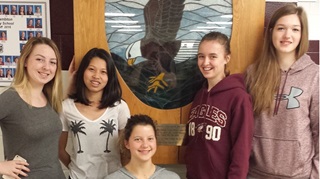Bringing Quebec’s rich history to life
Regional museum uses interactive approach to bolster kids’ civic pride
A gold taffeta evening dress. A grey silk wedding gown. A vibrant red military tunic.
These exquisite 19th-century outfits are just a few of the more than 500 garments and accessories displayed in the celebrated costume room of the Argenteuil Regional Museum, the jewel in a collection of more than 10,000 artifacts related to the history of this region of Quebec.
The costume room “is the part of our collection we’re best known for,” says Lyne St-Jacques, the museum’s director. “Many people come to the museum for the costumes, and then they discover other things through our exhibits about the history of the region.”
Located west of Montreal, the museum is housed in a former military barracks built in 1830 on the Ottawa River. Later in the century, the stone building was turned into a hotel before being refashioned in 1938—and is now the second-oldest private museum in Quebec.
With collections dedicated to Argenteuil’s fascinating history, the exhibits tell the story of the history, geography and people of the region, explains St-Jacques. The town was founded as a seigneurie under French rule, but, following the English victory in the Seven Years’ War, the town’s population was bolstered by immigrants from New England, Scotland, England, and Ireland.
For years, the community was an English enclave — Canadian Prime Minister John Abbott came from the area, and his daughter Alice’s wedding gown is part of the costume collection.
Under the leadership of St-Jacques and her team, the museum has been undergoing modernization over the past six years, with visits more than doubling in 2015. In the same year, the museum also earned a cultural tourism award for being an ambassador for the region.
St-Jacques and her team have refreshed major exhibits, like the history of the waterways, mills, factories, and the railway; they have digitized and translated documents; and, with funding from Enbridge, they have developed educational programs for school children.
“We had no education programs until Enbridge started supporting us,” St-Jacques says.
Since 2013, the museum has received financial support from Enbridge, in the form of three grants totaling $16,000. Now, as kids will come to the museum to experience the collections, lessons and information are presented in a way that maximizes their interest.
For Enbridge’s part, “supporting the museum offers the chance to enhance the education of students in a community where we live and work,” says Eric Prud’Homme, Enbridge’s Quebec-based senior manager of stakeholder and Aboriginal engagement.
Prud’Homme raves about the costume collection, and gratefully accepted St-Jacques’s offer to name the room for Enbridge.
“We’re proud to help (the museum) take their mission forward,” he says. “It can be a challenge to engage kids with an exhibit that is static. Lyne and her team have developed interactive ways to make these kids proud of the place they come from.”










